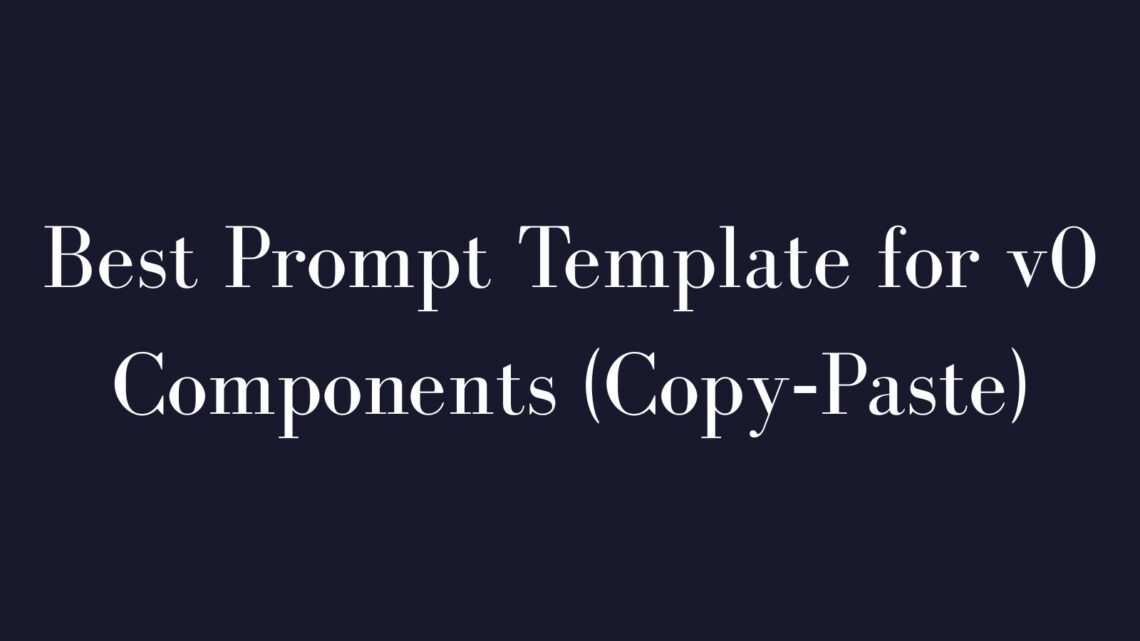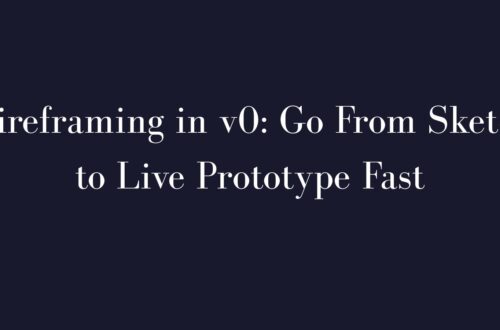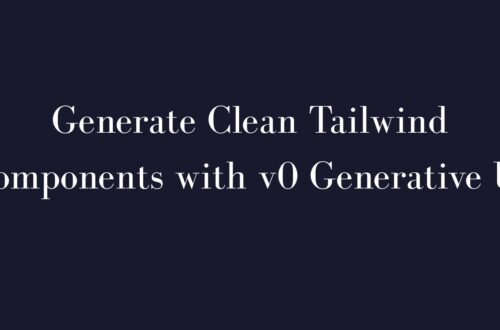Struggling to get v0 to build exactly the UI you want? The right v0 component prompt makes all the difference. This guide breaks down the best prompt template for v0 components, shows what fields to include, and provides a live example so you can get perfect UI on your first try.
Anatomy Of A Good Prompt
Think of a v0 prompt as a clear, concise design brief. The clearer your prompt, the better results v0 generates. Users have admitted needing “at least 20 versions” due to vague prompts (source: reddit.com). Avoid ambiguity by always clarifying:
- Component & purpose: What it is and why it’s needed.
- Content & features: Exactly what elements or functionality it must include.
- Design style: How it should look and feel (colors, layout, theme).
Example of a clear prompt:
Create a user profile card for a social app. Include avatar image, user’s name, short bio, and a “Follow” button. Use a modern, minimalist style with rounded corners and neutral colors.
Pro tip: v0 includes a built-in “prompt enhancer” tool to add detail automatically, but manual precision usually yields the best results.
Learn more about prompt engineering.
Required Fields
Required Fields
A strong v0 prompt template always covers these essential fields:
| Field | What to include | Example |
|---|---|---|
| Component & Purpose | Clearly state what you’re creating and why. | “Login form for finance app” |
| Content & Features | Specific elements or functionality required. | “Email/password fields, ‘Remember Me’ checkbox, Submit button” |
| Design Style | Colors, themes, layout details. | “Dark mode, rounded corners, blue accents” |
| Context (optional) | Specific usage context or constraints. | “Mobile-friendly design”, “Integrate with Chakra UI” |
Vercel’s team recommends including these fields explicitly to achieve best results with v0 (source: vercel.com).
Copy-paste Prompt Template:
[Component]: a [type of component] for [app or purpose].
[Content]: include [elements/features].
[Style]: use a [adjective/theme] design, [colors/fonts/layout specifics].
[Additional]: [optional context/library requirements].
Fill this template for consistent, high-quality results every time.
live example
Let’s see the template in action with a product card:
Prompt:
Design a product card component for an online store. Include a product image, product name, price, and an "Add to Cart" button. Use a clean, modern layout with a light background, subtle shadow, and rounded corners. Ensure it’s responsive for mobile and desktop.With this prompt, v0 generates a JSX/TSX product card component using Tailwind and shadcn UI:
- Clean, responsive card layout
- Product image placeholder
- Product title and price clearly visible
- Styled “Add to Cart” button
- Light background, subtle shadow, rounded corners
The output closely matches your initial vision, saving iterations.
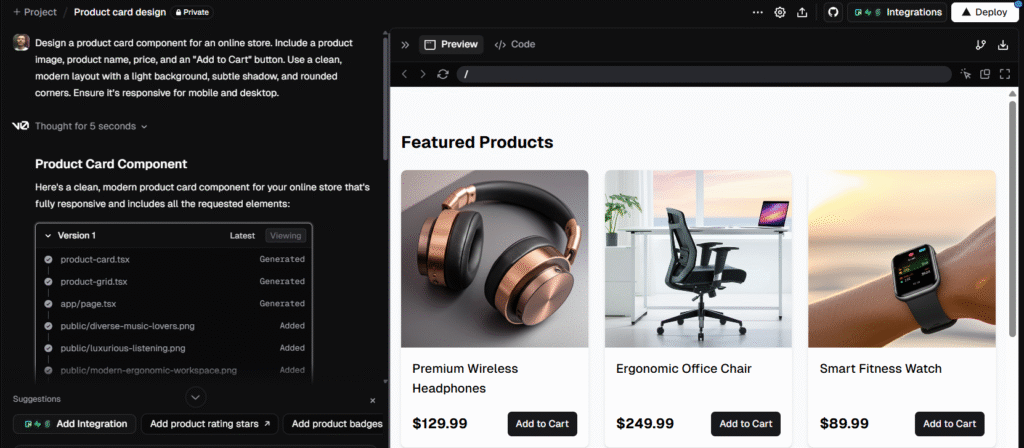
If you need minor tweaks, v0 allows easy follow-up prompts like “Add a 5-star rating below product name.”
New to v0? Check our v0 login & dashboard tour.
Style Variants
One prompt can yield many style variants simply by changing design cues. Consider these two examples based on the original product card:
- Dark Neon Theme: “Use a sleek, dark theme with neon blue accents.” Results in high-contrast, futuristic look.
- Playful Pastel Theme: “Use playful pastel pink and green with extra rounded corners.” Results in whimsical, inviting look.
Both keep the core product-card functionality intact but feel completely different visually.
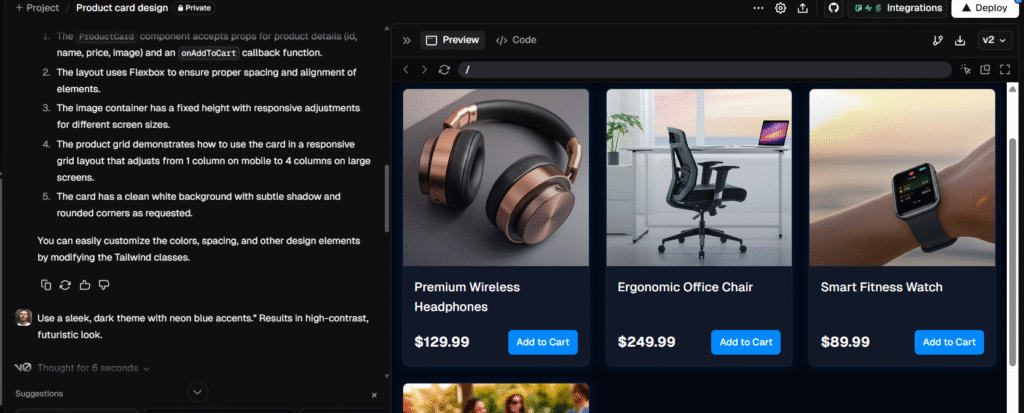

Community examples show how versatile this is—changing themes drastically with simple prompts like “bubble tea themed” (source: v0.dev).
FAQ
Why can’t I just say “make a login form”?
Generic prompts yield generic outputs. Specific details help v0 deliver accurate, ready-to-use UI, saving you many iterations.
What if v0 doesn’t nail it first try?
Iteration is normal. Refine the output with follow-up prompts (“change button color to blue”). v0 expects and excels at this back-and-forth improvement.
Prompt entire pages or single components?
Start component-by-component, then assemble into pages. Single large prompts can yield messy code; smaller prompts are clearer, resulting in cleaner outputs.
Can v0 match my brand styles?
Yes. Mention brand colors (hex codes), fonts, or style guides in prompts. v0 translates these to Tailwind classes or inline styles closely matching your branding.
Why use prompts instead of coding manually?
Speed and ideation. v0 rapidly scaffolds UI, letting you quickly test and iterate design ideas without manual boilerplate coding.
